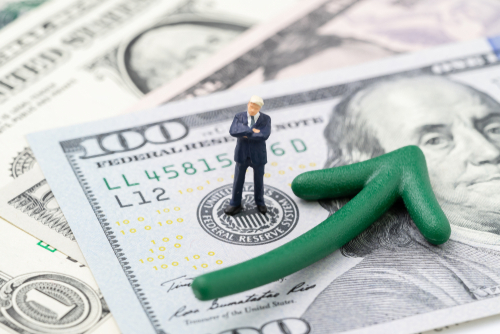
 There’s much uncertainty surrounding if, how and when the Federal Reserve will raise its rates, end its bond and mortgage-backed security purchases, and wind down its balance sheet. For the March 16 Fed Meeting, the CME FedWatch Tool has a 47.9 percent probability of a 25 to 50 basis point increase, and a 52.1 percent probability of a 50 to 75 basis point increase for their Target Rate. There are many expectations for the Fed to raise its Federal Funds rate, or the so-called overnight lending interbank rate. However, there’s a lot of uncertainty as to how many times the FOMC will increase it.
There’s much uncertainty surrounding if, how and when the Federal Reserve will raise its rates, end its bond and mortgage-backed security purchases, and wind down its balance sheet. For the March 16 Fed Meeting, the CME FedWatch Tool has a 47.9 percent probability of a 25 to 50 basis point increase, and a 52.1 percent probability of a 50 to 75 basis point increase for their Target Rate. There are many expectations for the Fed to raise its Federal Funds rate, or the so-called overnight lending interbank rate. However, there’s a lot of uncertainty as to how many times the FOMC will increase it.
John Williams, Federal Reserve Bank of New York president, mentioned at a recent event that the Federal Open Market Committee (FOMC) will start raising rates at its March 2022 meeting, but he isn’t advocating for a particularly hawkish approach. Rather, Williams expects inflation to drop due to supply-chain bottlenecks being naturally worked out, along with the Fed’s measured policy actions moderating inflation. However, James Bullard, Federal Reserve Bank of St. Louis president, is more hawkish and has expressed a desire for a 50 basis point rate hike.
Lael Brainard, a member of the Federal Reserve’s Board of Governors, believes six rate hikes are an appropriate course for monetary policy, starting in March 2022. Charles Evans, Chicago Fed president, blames inflation on the pandemic and echoes that supply chain issues will resolve on their own as the world returns to its new normal. Evans also believes that hiring won’t be slowed with higher rates, compared to past rate hike cycles. However, this could change if inflation grows too high as 2022 progress, necessitating more rate hikes.
The Fed has communicated clearly that it will let 1) evolving economic data, in conjunction with 2) maximum employment, and 3) 2 percent longer-term inflation expectations, guide its monetary policy. Noting there’s been a strengthening labor market, it’ll continuously look at how the pandemic is managed healthwise, how global developments unfold and how inflation is expected to and materializes.
It’s important to note that during August 2020, the Fed took a new approach to inflation. Previously, the approach would be to increase borrowing rates during good economic times to prevent inflation from becoming a problem. However, as of August 2020, the Fed’s new approach is to maintain low rates until inflation actually materialized, permitting economic conditions that drive inflation above and below 2 percent. This would thereby create a longer-term average inflation rate of 2 percent when considering monetary policy adjustments.
This is within the perspective of inflation reaching 7.5 percent year-over-year in January 2022, according to the Labor Department. Month-over-month inflation readings include electricity rising 4.2 percent from December 2021 to January 2022. Food costs rose by 0.9 percent in January 2022, up from another 0.5 percent increase in December 2021.
According to the FOMC’s Jan. 26 meeting minutes, there’s much to be contemplated for any potential rate changes. The members found that inflation was elevated, with economic indicators showing inflationary pressures increased in the back half of 2021. In December, the 12-month change in the consumer price index (CPI) was 7 percent, while core CPI inflation was 5.5 percent over the same period.
The year-over-year November 2021 total personal consumption expenditures (PCE) price inflation was 5.7 percent, with the core PCE coming in at 4.7 percent for the same timeframe. When it comes to the unemployment rate, it fell from 4.2 percent in November 2021 to 3.9 percent in December.
Impact of Russia-Ukraine Conflict
Looking at the price of crude oil alone shows how inflation is fluctuating. On Feb. 24, futures contracts at one point had oil hitting $100 and $105 per barrel for West Texas Intermediate and Brent, respectively. While prices retreated, prices are still elevated and subject to international tensions, increasing demand due to the economy reopening from COVID and uncertainty over future output. Undoubtedly, the Fed will take inflation into account – both its new definition of longer-term 2 percent inflation and how it might impact the economy. Some speculate with the high volatility beginning in 2022, the Fed may raise rates by only 25 basis points, not the 50 basis points more hawkish FOMC members have mentioned.
With increased volatility since 2022 began and global uncertainty increasing by the day, it seems the FOMC will have the final say on how many rate hikes will eventually happen.

